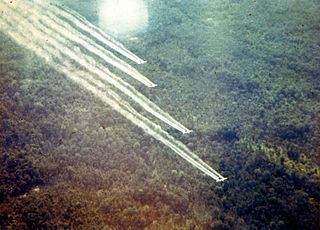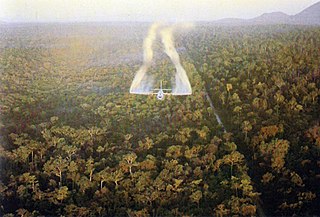
Agent Pink is the code name for a powerful herbicide and defoliant used by the U.S. military in its herbicidal warfare program during the Vietnam War. The name comes from the pink stripe painted on the barrels to identify the contents. Largely inspired by the British use of herbicides and defoliants during the Malayan Emergency, it was one of the rainbow herbicides that included the more infamous Agent Orange. Agent Pink was only used during the early "testing" stages of the spraying program before 1964.

Herbicides, also commonly known as weedkillers, are substances used to control unwanted plants. Selective herbicides control specific weed species, while leaving the desired crop relatively unharmed, while non-selective herbicides can be used to clear waste ground, industrial and construction sites, railways and railway embankments as they kill all plant material with which they come into contact. Apart from selective/non-selective, other important distinctions include persistence, means of uptake, and mechanism of action. Historically, products such as common salt and other metal salts were used as herbicides, however these have gradually fallen out of favor and in some countries a number of these are banned due to their persistence in soil, and toxicity and groundwater contamination concerns. Herbicides have also been used in warfare and conflict.

A defoliant is any herbicidal chemical sprayed or dusted on plants to cause their leaves to fall off. Defoliants are widely used for the selective removal of weeds in managing croplands and lawns. Worldwide use of defoliants, along with the development of other herbicides and pesticides, allowed for the Green Revolution, an increase in agricultural production in mid-20th century. Defoliants have also been used in warfare as a means to deprive an enemy of food crops and/or hiding cover, most notably by the United States in the Vietnam War.

Herbicidal warfare is the use of substances primarily designed to destroy the plant-based ecosystem of an area. Although herbicidal warfare use chemical substances, its main purpose is to disrupt agricultural food production and/or to destroy plants which provide cover or concealment to the enemy, not to asphyxiate or poison humans and/or destroy human-made structures. Herbicidal warfare has been forbidden by the Environmental Modification Convention since 1978, which bans "any technique for changing the composition or structure of the Earth's biota".
Agent Pink's only active ingredient was 2,4,5-trichlorophenoxyacetic acid (2,4,5-T), one of the common phenoxy herbicides of the era. Agent Pink contained about 60%–40% of this active substance. Even prior to Operation Ranch Hand (1962–1971) it was known [1] [2] [3] [4] [5] [6] that a dioxin, 2,3,7,8-tetrachlorodibenzo-para-dioxin (TCDD), is produced as a byproduct of the manufacture of 2,4,5-T, and was present in any of the herbicides that used it, but to greater proportion in the earlier Agents, such as Pink. [7]

Phenoxy herbicides are a family of chemicals related to the growth hormone indoleacetic acid (IAA). When sprayed on broad-leaf plants they induce rapid, uncontrolled growth. When sprayed on monocotyledonous (grass) crops such as wheat or corn, they selectively kill broad-leaf weeds, leaving the crops relatively unaffected. The wide variety of phenoxies in use today can be grouped into the phenoxyacetic, phenoxybutyric and phenoxypropionic subtypes, the latter containing the aryloxyphenoxypropionic subtype with the greatest number of commercial variants. Chemically, they are carboxylic acids, typically applied in an ester or salt form.

Operation Ranch Hand was a U.S. military operation during the Vietnam War, lasting from 1962 until 1971. Largely inspired by the British use of 2,4,5-T and 2,4-D during the Malayan Emergency in the 1950s, it was part of the overall herbicidal warfare program during the war called "Operation Trail Dust". Ranch Hand involved spraying an estimated 20 million U.S. gallons (76,000 m3) of defoliants and herbicides over rural areas of South Vietnam in an attempt to deprive the Viet Cong of food and vegetation cover. Areas of Laos and Cambodia were also sprayed to a lesser extent. Nearly 20,000 sorties were flown between 1961 and 1971.
Polychlorinated dibenzodioxins (PCDDs), or simply dioxins, are a group of polyhalogenated organic compounds that are significant environmental pollutants.
A 2003 Nature paper by Stellman et al., which re-apprised the average TCDD content of Agent Orange from the 3 ppm that USAF had reported to a level of 13 ppm, also estimated that Agent Pink may have had 65.5 ppm of TCDD on average. The comparatively smaller amounts of Pink and Purple—spraying of 50,312 l of Pink is documented, but an additional 413,852 l appear on procurement records—probably deposited a large percentage of the total dioxin. [7]

Nature is a British multidisciplinary scientific journal, first published on 4 November 1869. It is one of the most recognizable scientific journals in the world, and was ranked the world's most cited scientific journal by the Science Edition of the 2010 Journal Citation Reports and is ascribed an impact factor of 43.070, making it one of the world's top academic journals. It is one of the few remaining academic journals that publishes original research across a wide range of scientific fields.

Agent Purple is the code name for a powerful herbicide and defoliant used by the U.S. military in their herbicidal warfare program during the Vietnam War. The name comes from the purple stripe painted on the barrels to identify the contents. Largely inspired by the British use of herbicides and defoliants during the Malayan Emergency, it was one of the so-called "Rainbow Herbicides" that included the more infamous Agent Orange. Agent Purple and Orange were also used to clear brush in Canada.







